Stromanthe Triostar Care: How to Grow Stromanthe Plants
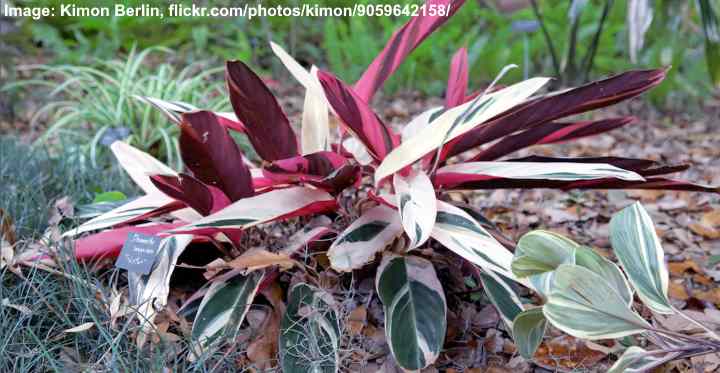
The Stromanthe sanguinea ‘Triostar’ is a spectacular tropical houseplant with striking colorful foliage. This exotic indoor plant is also named the Calathea ‘Triostar’, Stromanthe ‘Tricolor’ or ‘Tricolor Ginger.’ This plant has spectacular variegated leaves that are creamy-white and green with pink edging and purple undersides. Its long, broad, glossy leaves make an eye-catching feature in any room of your home.
How to care for Stromanthe sanguinea: The Stromanthe Triostar plant thrives in medium filtered light, well-draining potting soil, and high humidity. Water when the top layer of soil is dry to keep the growing medium moist, but not soggy. Grow the stromanthe tricolor in temperatures between 65°F and 80°F (18°C – 27°C). Fertilize twice a month in the growing season.
The Stromanthe sanguinea is a flowering plant that is a member of the Marantaceae family, making it related to prayer plants (Maranta plants). Sometimes calatheas are called prayer plants because they raise their leaves at night like prayer plants. In the evening, the leaves of calathea plants fold upright at the base of the stem, as if the plant is folding its leaves upward to pray. This process is called nyctinasty.
Its native habitat is the tropical rainforests of South America. There, the tri-colored leafy plant thrives in warm, humid conditions in the shade of the forest floor.
The botanical and common names of Stromanthe sanguinea ‘Triostar’ refer to the colorful foliage of this Stromanthe species. The names ‘Tricolor’ and ‘Triostar’ refer to the three colors on its elongated oblong leaves. The Latin name ‘sanguinea’ refers to the red underside of the leaves and the red flowers it produces. Other names for the Stromanthe Triostar are ‘Tricolor Ginger,’ ‘Magenta Triostar,’ and Stromanthe thalia.
Other popular varieties of the Stromanthe species are:
- Stromanthe amabilis (Calathea ‘Burle Marxii’)—This plant looks more like a typical type of prayer plant with green leaves with dark green markings.
- Stromanthe ‘Magic star’—Look for lance-shaped, dark green leaves with silvery speckles and a deep red underside.
In this article, you’ll find out how to look after a Stromanthe Triostar at home. At the end of the article, learn about how to care for a Triostar plant showing signs of disease, brown leaves, or yellowing leaves.
Stromanthe Sanguinea Triostar Care Guide
With the right care and attention, it is possible to grow a Stromanthe Triostar at home successfully. This magenta tricolor needs adequate humidity, the correct type of potting medium, and enough light. These care requirements ensure that its colored foliage stays bright and vibrant all year long.
Light Requirements for Healthy Stromanthe Sanguinea Triostar
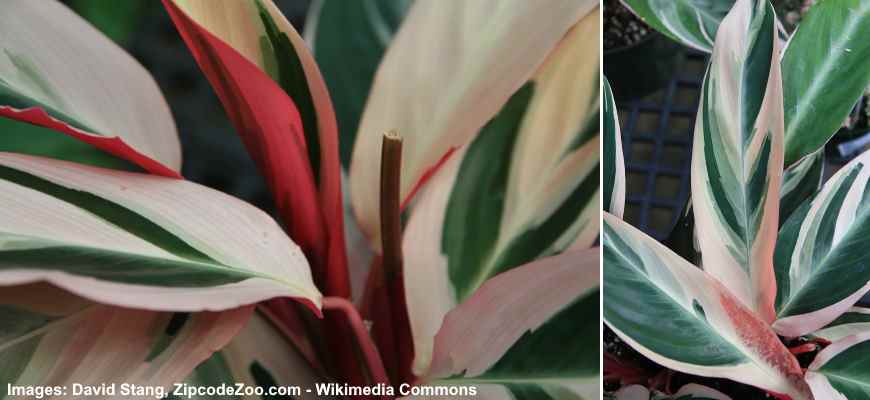
Grow your Stromanthe sanguinea ‘Tricolor’ in medium indirect light
The Triostar plant thrives in medium light, away from direct sunlight. The best location for this species of Stromanthe is near an east-facing window or on a north-facing windowsill. Even though variegated plants tend to need bright light, the Tricolor Ginger grows well in average lighting conditions.
Indeed, most variegated plants are not types of low-light plants. However, the fascinating leaves of this Stromanthe species react to light differently. The plant leaves turn toward or away from sunlight to catch as much light as possible. If the light is too bright, they turn to show the red underneath. This action helps protect the leaves from too much intense sunlight.
The way that Stromanthe Tricolor plants react to light can make growing them indoors challenging. As long as you keep them away from direct sunlight, they should thrive. If you notice that leaves develop dry brown spots, move to a shadier location. If the variegation starts to fade, then your plant may need more light.
How to Water Stromanthe Sanguinea Triostar
Proper watering is the most crucial care requirement for Stromanthe Triostar or Tricolor Ginger. As a general rule, only water Stromanthe plants when the top 1” (2.5 cm) layer of soil is dry. Tricolor plants like to grow in soil that’s slightly moist but never waterlogged or arid.
Letting the top layer of soil partially dry helps ensure that the potting mix is always moist without becoming soggy. To check how often to water a Triostar, press down on the soil to make sure it’s dry. However, remember that these fussy indoor plants don’t like periods of drought.
Water quality is another vital care requirement with these exotic plants. Try to use rainwater, distilled water, or filtered water to hydrate your Triostar—and make sure it’s at room temperature. Chemicals in tap water can build up in the soil and affect the plant’s growth.
The best way to water you Stromanthe Triostar is to drench the soil. This houseplant watering method ensures proper hydration. To water the plant, pour filtered water through the soil until it drains through the holes in the pot’s base. Allow excess water to drain and then return to its place.
Vital watering tips for Stromanthe Triostar:
- Make sure your pot has drainage holes in the bottom.
- Only use light, well-draining potting soil.
- Give plants a deep watering when the top layer of soil is dry.
- Don’t let your Triostar plant dry out completely.
- Remember that humidity is just as important as proper watering.
- Water less frequently in the winter months, always using soil moisture levels as a guide.
The Best Potting Soil for Indoor Stromanthe Triostar Plants
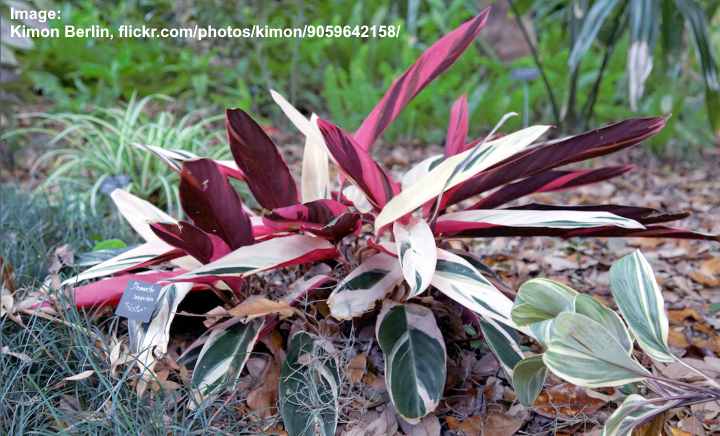
To care properly for your Stromanthe triostar make sure to plant it in a well-draining soil
The best soil for Stromanthe Triostar plant is well-draining potting mix. An ideal combination for your stromanthe plant is potting soil, peat moss, and perlite. The organic matter provides nutrients and holds moisture, and the perlite makes the medium light and improves drainage.
The best potting soil needs to allow water to drain quickly and freely. Stromanthe Triostar plants are sensitive to excess soil moisture, so you need to prevent soil from staying damp. If you notice that water starts to drain slowly, you’ll need to amend the soil with perlite or orchid bark.
When it comes to pot size, don’t choose a pot or container that is too large for your plant. Oversized pots tend to hold too much moisture and cause problems with dampness. This can lead to root rot and end up killing your sensitive tropical plant.
Temperature Range for Stromanthe Sanguinea Triostar
Average room temperatures are ideal for growing Triostar plants indoors. Keep an even temperature between 65°F and 80°F (18°C – 27°C). The only temperature care requirement is to avoid sudden temperature fluctuations. Protect from cold drafts and hot radiators to prevent distressing the plant.
You can grow Stromanthe Triostar plants outdoors in USDA zones 10 to 12. If you live in colder climates, you can take your potted Triostar plants outside in summer. Place the container where it gets dappled sunlight and protection from strong winds. Take back indoors when it drops below 60°F (15°C).
Humidity Requirements for Stromanthe Triostar
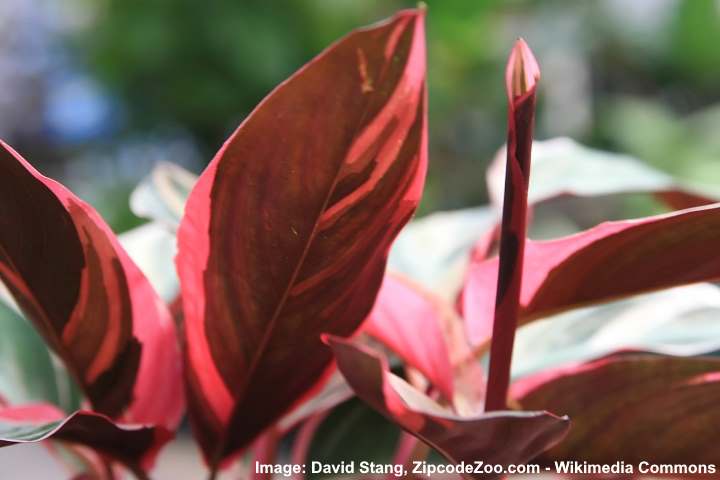
Stromanthe Triostar thrives in high humidity of at least 50%
Native to tropical rainforests, Stromanthe sanguinea Triostars have high humidity requirements. Aim for at least 50 percent humidity indoors to help your plant thrive and maintain its vibrant foliage. Mist the leaves every other day or place on a pebble humidifying tray to help hydrate the leaves.
Low humidity can cause leaves to droop and attract spider mites. You can keep your plant in a humid room such as a bathroom or kitchen. The high air moisture levels are perfects for many tropical plants that need filtered light, warmth, and humidity.
If you need to increase indoor humidity to help your Triostar thrive, make sure that room temperature is at least 65°F (18°C). High humidity and cold encourage fungal diseases to develop in the soil that can lead to root rot.
Stromanthe Triostar Fertilizing Needs
Stromanthe Tricolor plants are moderate feeders and benefit from bi-monthly feeding during the growing season. Use a balanced liquid houseplant fertilizer and dilute to one-quarter strength. Feed every two weeks when you water your plant. You can also use an organic fertilizer such as worm castings.
To ensure healthy growth and prevent leaves from yellowing, don’t overdo the feeding. Too much fertilizer can negatively affect the plant’s growth and cause the plant to die. Once or twice in the growing season, flush the soil with filtered water to wash out excess salts.
Stromanthe Triostar Size and Growth Rate
The Stromanthe sanguinea cultivar ‘Triostar’ has upright growth that can reach to about 1 ft. (30 cm) in height. The bushy growth habit of the lanceolate, oblong leaves, has a spread of up to 1.5 ft. (45 cm). In ideal conditions, Stromanthe Tricolor plants have moderately fast growth.
There are a few reasons why the plant’s growth rate starts to slow. Lethargic growth could be due to poor lighting, not enough feeding, or being root-bound. Also, these temperamental plants can seem to stop growing for a while after repotting.
How to Prune a Stromanthe Sanguinea Triostar

Pruning a Triostar is only ever required to remove dead or damaged leaves. Because the plant has stems that grow straight out of the ground, you should prune the affected stems at the base. Always use a sharp, sterilized blade to remove unwanted foliage.
To prevent affecting the plant’s growth, never remove more than 30 percent of the Stromanthe Tricolor’s foliage. Pruning this way ensures that light gets to all parts of the plant, and you’ll avoid stressing it too much.
Repotting Stromanthe Triostar Plants
You should only repot a Triostar plant when absolutely necessary. Repotting stresses Stromanthe plants, and some plants may take a long time to recover. You will only have to repot your exotic houseplant every few years at the most. But because they prefer being rootbound, this isn’t a problem.
When repotting your Triostar, either use the same size of pot if you don’t want it to grow bigger or choose a larger container—one size up.
To repot a Stromanthe sanguinea Triostar, this is what you should do:
- Gently ease the root ball from its existing container.
- Shake off the old dirt from the roots.
- Check the roots for dead, brown mushy ones and trim as necessary.
- Half-fill the new pot with the appropriate light, well-draining potting mix.
- Put in the plant and fill the rest of the space with the remaining soil.
- Gently press down, but not too much to avoid compacting the soil.
- Thoroughly water the plant and put it in bright indirect light.
- After about four weeks, the Triostar should have recovered from the shock, and you can start caring for it as usual.
Stromanthe Sanguinea Propagation
The best way to propagate a Stromanthe sanguinea or Magenta Triostar is by root—rhizome—division. Plan to propagate Triostar plants in spring when their growth is vigorous. All you need to do it separate the clumps, ensuring that each one has at least one stem with a healthy leaf.
You can propagate Stromanthe or Calathea Tricolor plants at the same time when you repot them. Planning to propagate the plant every few years saves unduly stressing the plant. Put the new cutting in the appropriate size of pot and use a light, fertile potting mix that has excellent drainage.
Some plant owners recommend using Stromanthe cuttings for propagation. However, stem cuttings are difficult—if not impossible—to propagate.
Stromanthe Triostar Flowers
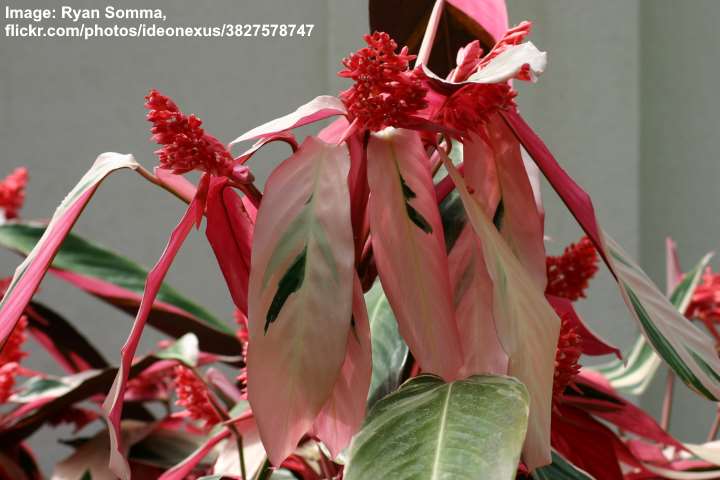
Stromanthe Triostar houseplant rarely flowers indoors
Stromanthe Triostar plants produce red-orange flowers in early spring. The blossoms start as orangey bracts that surround the flowers. Small clusters of cherry pink flowers emerge from the bracts when the plant blooms. Stromanthe Triostars regularly bloom in their native environment.
Stromanthe houseplants rarely bloom when growing indoors. However, this doesn’t concern most plant owners because the striking creamy-white, green, and pink foliage is more spectacular than the inconspicuous flowers.
Diseases and Pests Affecting Stromanthe Triostar Growth
Triostar plants are relatively hardy plants, despite their reputation for being fussy houseplants. The only two things to watch out for are fungal diseases and aphid problems. Humid conditions make the houseplant susceptible to mold and root rot. Aphids can affect any indoor plants, and Triostars are not immune.
Usually, proper watering techniques prevents any problems with white soil mold or fungal disease. If you notice any of these issues, hold off watering until the soil partially dries out. In a worst-case scenario, you may have to repot the plant in fresh potting soil.
If you notice signs of aphids, you will need to take quick action against these sap-sucking pests. Apart from killing your plant, they can infest more of your houseplants—certainly not something any plant owner wants.
To get rid of aphids quickly and effectively, you can use a natural neem oil solution for houseplant pests. Please check out this article for more ways to eradicate bugs from your indoor plants.
FAQs About Stromanthe Triostar Care
Stromanthe Triostar plants are not the easiest houseplants to grow indoors. Even under seemingly ideal conditions, your Stromanthe tricolor may get problems with brown leaves or wilting growth. Read on to find out how to keep your Stromanthe plant healthy and thriving.
Are Stromanthe plants toxic to cats and dogs?
No, plants in the Marantaceae family, such as Stromanthe Triostar, don’t contain toxic substances. So, tricolor stromanthe plants are safe if you’ve got cats, dogs, or other pets.
Why are the leaves on my Stromanthe Triostar turning brown?
Brown leaf edges are usually a sign that your Triostar plant lacks humidity. Dry household air tends to turn leaf tips and margins brown and crispy. If air is mainly arid, you may have brown spots appearing on leaves. Mist the leaves daily to help your Stromanthe tricolor thrive.
Why is my Stromanthe Sanguinea leaves turning yellow?
The two main reasons why Stromanthe Triostar leaves become yellow are overwatering or too little sunlight. To remedy these growing issues, do one of the following. Either water your Stromanthe less often—when the top layer is dry. Or, move your plant pot to a brighter location, away from direct sunlight.
My Stromanthe Triostar leaves are wilting, what should I do?
A lack of moisture is usually to blame for Stromanthe Tricolor leaves that appear withered and, possibly, with crispy brown patches on them as well. To help revive your plant, thoroughly drench the soil and mist the leaves. Make sure and keep your Triostar away from heaters or air conditioners.
My Stromanthe Triostar leaves are curling, what’s wrong?
Curling Stromanthe leaves are a sign that the plant is distressed. The causes of curled leaves could be low humidity, temperature extremes, water quality, or overwatering. To help restore the beautiful white, green, and pink foliage, try to improve the growing environment by resolving the underlying cause.
Why is my Stromanthe Triostar dying?
Drooping leaves that have curled up give the appearance that your Stromanthe tricolor is dying. Find out what is causing your plant to die. To help revive a dying Stromanthe, try repotting it in a sterile potting mix. Also, check for plant pests and take steps to eradicate them.
Are Stromanthe Sanguinea Triostar easy houseplants to look after?
Although Stromanthe Triostars aren’t the easiest indoor plants to care for, they aren’t the most difficult. Keeping the plants in medium indirect light, watering them often enough, and maintaining high humidity should allow you to enjoy their beautiful foliage for many years.
Related articles:
